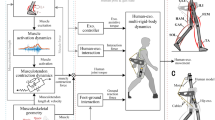Abstract
Adaptive gaits of humans were produced as a result of emergent properties of a model based on the neurophysiology of the central pattern generator and the biomechanics of the human musculoskeletal system. We previously proposed a neuromusculoskeletal model for human locomotion, in which movements emerged as a stable limit cycle that was generated through the global entrainment among the neural system, composed of neural oscillators, the musculoskeletal system, and the environment. In the present study, we investigated the adaptability of this model under various types of environmental and task constraints. Using a computer simulation, it was found that walking movements were robust against mechanical perturbations, loads with a mass, and uneven terrain. Moreover, the speed of walking could be controlled by a single parameter which tonically drove the neural oscillators, and the step cycle could be entrained by a rhythmic input to the neural oscillators.
Similar content being viewed by others
References
Beer RD (1990) Intelligence as adaptive behavior. Academic Press, London
Berger W, Dietz V, Quintern J (1984) Corrective reactions to stumbling in man: neuronal co-ordination of bilateral leg muscle activity during gait. J Physiol 357:109–125
Bonnard M, Pailhous J (1993) Intentionality in human gait control: modifying the frequency-to-amplitude relationship. J Exp Psychol Hum Percept Perform 19:429–443
Clark JE, Truly TL, Phillips SJ (1993) On the development of walking as a limit cycle system. In: Smith LB, Thelen E (eds) A dynamic systems approach to development: application. MIT Press, Cambridge Mass., pp 71–93
Dietz V (1992) Human neuronal control of automatic functional movements: interaction between central programs and afferent input. Physiol Rev 72:33–69
Doya K, Yoshizawa S (1992) Adaptive synchronization of neural and physical oscillators. In: Moody JE, Hanson SJ, Lippmann RP (ed) Advances in neural information processing systems 4. Morgan Kaufmann, San Mateo pp 109–116
Drew T (1988) Motor cortical cell discharge during voluntary gait modification. Brain Res 457:181–187
Ekeberg Ö (1993) A combined neuronal and mechanical model of fish swimming. Biol Cybern 69:363–374
Furusho J, Sano A (1991) Development of biped robot. In: Patla AE (eds) Adaptability of human gait. Elsevier Science, North-Holland Amsterdam, pp 277–303
Georgopoulos AP, Grillner S (1989) Visuomotor coordination in reaching and locomotion. Science 245:1209–1210
Grillner S (1985) Neurobiological bases of rhythmic motor acts in vertebrates. Science 228:143–149
Inman VT, Ralston HJ, Todd F (1981) Human walking. Williams& Wilkins, Baltimore
Kalaska JF, Drew T (1993) Motor cortex and visuomotor behavior. Exercise Sport Sci Rev 21:397–436
Kimura S, Yano M, Shimizu H (1993) A self-organizing model of walking patterns of insects. Biol Cybern 69:183–193
Matsuoka K (1985) Sustained oscillations generated by mutually inhibiting neurons with adaptation. Biol Cybern 52:367–376
Miura T, Shimoyama I (1984) Dynamic walk of a biped. Int J Robot Res 3:60–74
Miyazaki S, Yamamoto S (1993) Moment acting at the metatarsophalangeal joints during normal barefoot level walking. Gait Posture 1:133–140
Nilsson J, Thorstensson A (1987) Adaptability in frequency and amplitude of leg movements during human locomotion at different speeds. Acta Physiol Scand 129:107–114
Patla AE (1991) Visual control of human locomotion. In: Patla AE (ed) Adaptability of human gait. Elsevier Science, North-Holland, Amsterdam pp 55–97
Raibert MH (1984) Hopping in legged systems-modeling and simulation for the two-dimensional one-legged case. IEEE Trans SMC 143:451–463
Raibert MH, Hodgins JK (1992) Legged robots. In: Beer RD, Ritzmann RE, McKenna T (eds) Biological neural networks in invertebrate neuroethology and robotics. Academic Press, London, pp 319–354
Schöner G (1993) From interlimb coordination to trajectory formation: common dynamical principles. In: Swinnen S, Heuer H, Massion J, Casaer P (eds) Interlimb coordination: neural, dynamical, and cognitive constraints. Academic Press, London, pp 339–368
Schöner G, Kelso JAS (1988) Dynamic pattern generation in behavioral and neural systems. Science 239:1513–1520
Shik ML, Severin FV, Orlovsky GN (1966) Control of walking and running by means of electrical stimulation of the mid-brain. Biophysics 11:756–765
Soest AJ van, Bobbert MF (1993) The contribution of muscle properties in the control of explosive movements. Biol Cybern 69:195–204
Taga G (1994) Emergence of bipedal locomotion through entrainment among the neuromusculoskeletal system and the environment. Physica D 75:190–208
Taga G (1995) A model of the neuromusculoskeletal system for human locomotion. I. Emergence of basic gait. Biol Cybern 73:97–111
Taga G, Yamaguchi Y, Shimizu H (1991) Self-organized control of bipedal locomotion by neural oscillators in unpredictable environment. Biol Cybern 65:147–159
Taga G, Miyake Y, Yamaguchi Y, Shimizu H (1993) Generation and coordination of bipedal locomotion through global entrainment. Proc Int Symp Autonomous Decentralized Systems. IEEE Computer Society Press, pp 199–205
Takanishi A, Lim H, Tsuda M, Kato I (1990) Realization of dynamic biped walking stabilized by trunk motion on a sagittal uneven surface. IEEE Int. Workshop on Intelligent Robots and Systems, pp 323–330
Vukobratovic M, Stokic D (1975) Dynamic control of unstable locomotion robots. Math Biosci 24:129–157
Author information
Authors and Affiliations
Additional information
Part of this paper was done at Yukawa Institute for Theoretical Physics, Kyoto University, Japan
Rights and permissions
About this article
Cite this article
Taga, G. A model of the neuro-musculo-skeletal system for human locomotion. Biol. Cybern. 73, 113–121 (1995). https://doi.org/10.1007/BF00204049
Received:
Accepted:
Issue Date:
DOI: https://doi.org/10.1007/BF00204049




